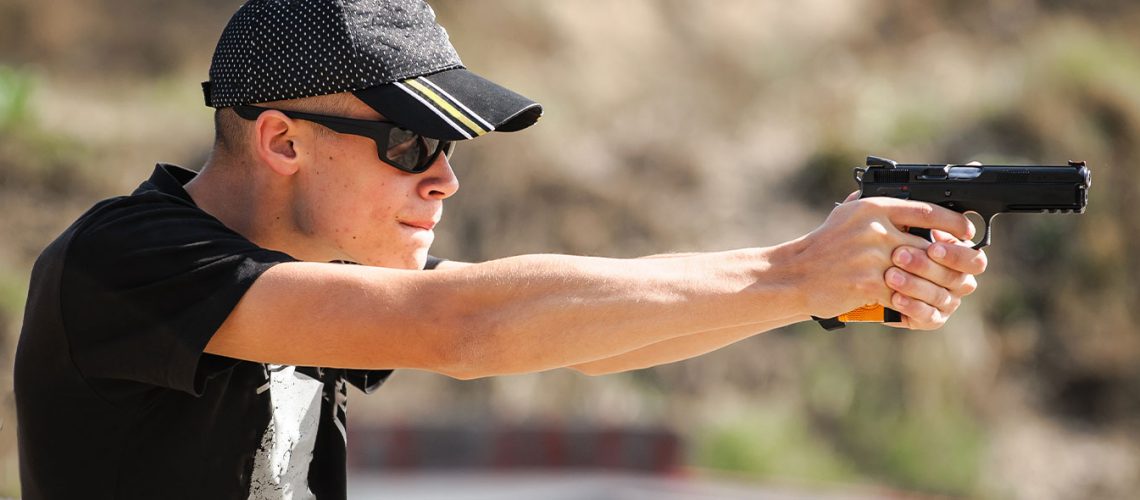Among the popular features of the Firearms Legal Protection monthly newsletter is the Tip Of The Month. Each and every month, we offer up a handy tip that can broaden your firearm knowledge and performance.
We’ve assembled all of the 2022 tips right here, in one place, where you can see them all. A great reminder to sign up for our newsletter—it’s absolutely free—if you haven’t already.
 JANUARY
JANUARY
TRAINING & DEFENSE GOALS
New Year’s resolutions are pretty cliché, and your local gym will probably be packed on January 1st, but how about making a New Year’s resolution, or at least setting a goal this year related to your personal defense?
Perhaps there has been something that you have been meaning to do for a while, or a skill that you have wanted to learn. Now is a great time to pull out the calendar (or at least a sticky note!) and write out a measurable goal related to personal protection. In case you need some inspiration, here are some ideas:
Get a more comfortable holster
Carry regularly
Attend a handgun class
Go to the range at least once a month
Attend a martial arts class
Attend a tactical carbine class
Organize your ammo stash
Sell a gun you no longer use and get something you prefer
Write out a home defense plan
Put night sights and/or a light on your home defense gun
Improve your firearm storage system
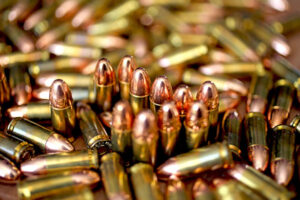 FEBRUARY
FEBRUARY
AMMO POOL
Maybe you and your friend both shoot a lot of 9mm, or 5.56 NATO. There are many websites where you can buy ammo in bulk and save it. No different than shopping at Sam’s Club or Costco, you can find better rates on common ammunition by purchasing in bulk.
However, the shipping cost of heavy ammunition can quickly push this into regular retail pricing. Find a couple of buddies and split a bulk case of the caliber that you all need. You can split the shipping, get a good deal, and make fewer trips to the store. This works especially well with a common pistol or rifle calibers, and military surplus. Specialty ammunition can be hard to find in bulk, and shotgun shells are often too expensive to ship to be worth purchasing this way. If you are lucky enough to find a free shipping coupon, you just saved even more!
 MARCH
MARCH
WHO SHOULD YOU TALK TO AFTER A SELF-DEFENSE ENCOUNTER?
Most people are aware that after a self-defense incident they should not talk to the police. We have all heard the saying “anything they say can and will be used against you”.
What if you talk to a friend, other people at the scene, or even your family? Can what I say to anyone be used against me in court? The short answer is yes. If you talk to anyone about what happened about your self-defense encounter, that person could be subpoenaed to come to court and testify about what you said, your demeanor, and any other issues that could be used to in order to assist in your prosecution.
This applies to anyone and everyone with only a few exceptions. Most people are not aware that your spouse could be compelled to testify against you. Unfortunately, this means you may not be able to talk to your spouse about anything regarding your self-defense encounter. This will be dependent upon the State you live in at the time to determine if spousal privilege applies. The one person that cannot be compelled to testify against is your attorney. You can and should tell your attorney everything about your self-defense encounter without worrying about the attorney using anything against you. Your attorney is the one person that knows the legal system and can help guide you throughout the process. Make sure you contact your attorney immediately and tell them everything that happened. As a Firearms Legal Protection member simply call the Emergency Hotline number after your self-defense encounter, an attorney will answer and help you 24/7/365.
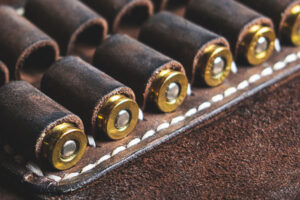 APRIL
APRIL
BACK TO BASICS
Whether you are brand new to shooting sports or you are the toughest high-speed operator around, no one is above going back to the basics and shooting a 22LR handgun showly and comfortable at a paper target trying to be as precise as possible.
While shooting the 9mm or .45 you carry and shooting from different positions is certainly more “real world”, it is not necessarily the best way to hone your fundamentals. It can be beneficial to step away from the recoil, remove the “Clang” of steel targets, and go back to focusing on perfecting your grip, sight alignment, and trigger pull. Focus on shooting a 1-inch group, even if it has to be at close range. Then gradually work back. These fundamentals are the building blocks of every other practical shooting skill. Don’t ever assume you have learned them and move on to other things. Occasionally take time to go back and hone these skills. This keeps you accurate and effective and reduces the chances of picking up bad habits when you get into larger calibers and guns with different applications.
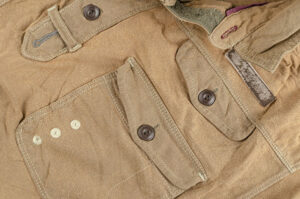 MAY
MAY
DRESS FOR SUCCESS
When thinking about firearms, think about what you’re wearing. That is, what will you put on to make your shooting experience easier, safer, more precise, or just more convenient?
Many people choose to wear safety shooting glasses for both protection and to provide clarity and contrast on their target, whether hunting or shooting at the range. Plus, there’s that UV coating. The next piece of your wardrobe should be earplugs or some hearing protection. Then, there’s your holster, which can be chosen for ease of access, or just comfort, as well as concealment. (It can also come on a belt that holds ammo, which is also convenient.) If you want to get further adorned for shooting, there’s always a tactical shirt that can hold ammo, magazines, or even earplugs. It’s up to you, but remember that your firearm is just part of the picture. And the time to realize you’re underdressed isn’t after you’re getting ready to fire. So, remember to dress for success regardless of whether you’re hunting or target shooting on the range.
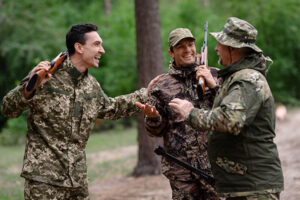 JUNE
JUNE
BUILD COMMUNITY
How did you first get interested in self-defense or start learning about shooting and gun safety? Did you have a mentor? Maybe you did, and having a voice of experience was helpful to guide you. Or maybe you did not, and you had to learn lessons the hard way.
This month, we urge you to pay it forward. Pass on a bit of what you know, share resources, and help build community by educating those around you. Maybe you know someone who has mentioned going to the range, or wanting to learn about shooting, but would never go by himself or herself. Invite that person to go with you! Are there books, magazines, podcasts, YouTube channels, or other media that helped you learn about firearms and self-defense? Share those with others who may be looking to learn more. The gun community is notorious for “in-fighting” and it is easy to find online forums bickering over 1911 vs. Glock, 9mm vs 45, or 6.5 Creedmoor vs. 308 Winchester. Just like it is often easiest to argue with your friends, family, or those close to you, the firearms industry often argues “within the family” instead of working together to provide helpful information and to promote safe and responsible gun ownership. This month, think about how you can build a community with like-minded individuals.
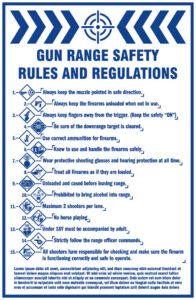 JULY
JULY
RANGE ETIQUETTE: RULES OF FIREARM SAFETY
Having a safe and secure firearm is a full-time responsibility, especially when you are at the shooting range. Practicing proper range etiquette is extremely important for your safety and for the safety of others. Whether it’s your first or hundredth time at the shooting range, it doesn’t hurt to have a refresher on some of the terms and gun range safety tips. It is easy to spot those who are undereducated about safe and considerate practices at the range; they tend to be disruptive and create a tense environment for others.
The basics of range etiquette are to know the rules of firearm safety, prepare range gear, range lingo, and cease-fire etiquette. For this month’s newsletter, we will touch on the rules of firearm safety:
Treat all firearms as if they’re loaded
Keep the muzzle pointed downrange
Keep your finger off the trigger until you’re ready to fire
Know your target and what’s beyond it
Those with years of experience can become so comfortable going to the range that it causes complacency. Refreshing these universal rules of firearm safety can help ensure that you do your part by avoiding an accident.
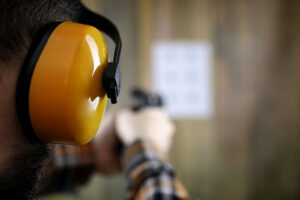 AUGUST
AUGUST
RANGE ETIQUETTE: RANGE LINGO
In last month’s newsletter we went over the basics on firearm safety, but there are other courtesies to follow when visiting the shooting range. Below are some of the most frequent terms you should know before going to the range so you can practice safely.
Firing line: This line is visible on the ground and usually looks like a painted stripe across the floor and determines where a shooter may stand. You must be positioned at the line before shooting and loading your weapon. When cease fire is called, you must be behind the firing line as well.
Downrange: This term is used when shooters are past the line of fire, and this usually occurs during a cease-fire, due to an individual crossing the line of fire and who could be walking in front of shooters.
Hot and Cold: When a range is “hot” that means the shooters are active, and you can continue to fire. When the range is hot, then no one should step past the line of fire. When a range is “cold”, this means all shooters have unloaded their weapons and “showed clear” (usually locking back the slide, opening the bolt, etc.) This is when you may go downrange.
“Eyes” and “Ears”: It may be obvious enough, but this term refers to eye protection and hearing protection. You don’t want to damage your own vision or hearing and you don’t want to be the guy who pops off a round when your neighbor has removed his hearing protection.
Double Doors: This one is less obvious. Most indoor ranges have a set of double doors creating an “airlock”. This is for the air filtration system, but also for sound reduction. Always let one set of doors close behind you before opening the next set. While you may be trying to be polite and hold the door for someone, you may be introducing loud sounds to people who have just removed their ear protection.
Backstop: The backstop is almost a safety net that is either a wall or a barrier behind the targets. Therefore, it is important to shoot parallel to the ground so if there are any stray bullets or you miss the target, it will safely be blocked by the backstop.
With time and practice, you will get the hang of the range lingo quickly. If you forget a term, just make sure to ask an experienced shooter or even keep this Tip of the Month in your notes. SEPTEMBER
SEPTEMBER
FIRST GUN PURCHASE?
Purchasing your first firearm is an exciting milestone! For a first purchase, we recommend going to a local gun store.
Sure, you can find some great deals online, but online purchases must be shipped to licensed retailer anyway, so you should take full advantage of the gun shop experience, to touch, hold, and even test out different models.
You may not know exactly what gun you want, but you should have a good feel for WHY you want it. Ultimately, firearms are tools optimized for specific functions. Going in knowing whether you want a concealed carry pistol, a rimfire rifle, or shotgun for bird hunting will help quickly narrow down the options. A good salesman will always ask “what is the primary purpose?” to be able to make a great recommendation.
Have some idea of your budget. Many are skeptical when a salesman immediately asks, “What is your budget?” thinking that throwing out a number will take lower-priced options off the table. Most likely, the salesman just doesn’t want to waste everyone’s time showing you options that are out of your price range and instead focus on the best options in your budget. If you know your budget you can narrow down your choices based on feel and features. Of course, you can also work the other way – know a list of features and requirements first, then narrow down by cost, but this is often a bit more difficult or better for shooters who already know exactly what they want. For a helpful list of considerations before your first (or any) firearm purchase, check out our blog article that provides a great list of helpful tips! https://firearmslegal.com/considerations-when-purchasing-a-firearm/
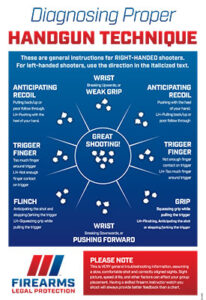 OCTOBER
OCTOBER
HANDGUN DIAGNOSTICS
Need to improve your pistol shooting? There is no substitute for practice at the ranger and a great instructor. Having a knowledgeable observer watch your technique is paramount to diagnosing issues and bad habits.
A diagnostic target can also be a helpful tool for new shooters when trying to improve marksmanship skills. Download the document to bring with you to the shooting range to help identify some common issues. Handgun diagnostics: https://firearmslegal.com/wp-content/uploads/2022/09/Poster_Handgun_Diagnostic_12x18_PG01.pdf
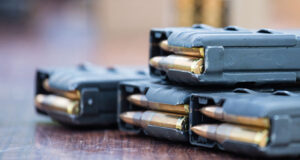 NOVEMBER
NOVEMBER
GUN MAGAZINE ORGANIZATION
Have you ever wondered why people have different colored tape on the bottom of their magazines? One reason for using different colored tape on magazines is to differentiate between types of ammunition.
There are multiple color systems you can choose from when organizing your magazines to efficiently and quickly determine which magazine you need to grab. There is not a universal meaning behind the color selection, so that part is up to you. Make sure to use removable adhesive so that you can easily change out your color selection for that magazine if needed.
Here are some examples of color systems you could use.
Training purpose: You can use colors to indicate between defensive ammo, match-grade competition ammo, plinking ammo, hunting ammo, or even new ammo that you are testing.
Potentially Dangerous Combinations: 300 Blackout can fit in a 5.56 magazine. 357 Sig can fit in a 40sw magazine. 6.5 Creedmoor uses 308 magazines. Using a label or colored tape can alert you to something different about the ammo inside the generic magazine to avoid a dangerous mix-up.
Bullet type: You can mark your magazine with red tape for regular FMJ, yellow for hollow points, green for green tips, and black for soft points.
Identifying personal magazines: Some tape their magazines just to ensure you, or your friends will not get confused. This can be especially helpful in a group training environment when the range is littered with Glock and Sig magazines. Whether it is for safety, or just staying organized, consider a labeling, taping, or color-coding system for your magazines. Just make sure you test the magazine with the tape to make sure it does not interfere with the operation of the firearm.
 DECEMBER
DECEMBER
EYE DOMINANCE
Discover your eye dominance to assist with proper sight alignment. You might have been taught this back in grade school, but a refresher never hurts! An easy way to check which is your dominant eye is to extend your arms forward and form a triangular opening between your hands.
Center the triangle on an object in the distance. Then, without moving your hands, close one eye at a time, alternating each eye. The eye with which you are able to view the object is your dominant eye.
You may discover you are a cross-eye dominant shooter, which means hand and eye dominance are opposite. This could make shooting a little difficult, but you may decide to try to shoot on your dominant-eye side. This means shooting with your non-dominant hand and spending extra time training. Or you may decide to train with your strong-side eye to be dominant.
Understanding your eye dominance, as a shooter, may lead to a simpler shooting experience. It could potentially improve your shooting accuracy as well as your hand-eye coordination.
As you can see, over the course of 2022, Tips Of The Month offered up a dozen great suggestions to enhance your shooting experience. Just one of the many reasons to sign up for the newsletter today.
